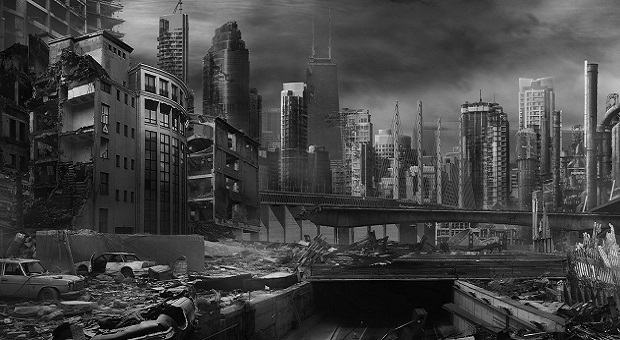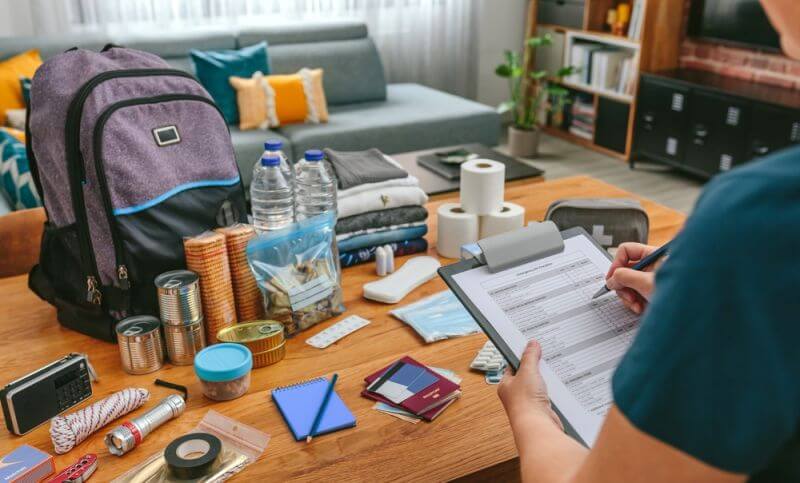Whether you’re unsure of how to plan for a bug out situation because you don’t know where you would bug out to, or you simply prefer the idea of battening down the hatches in your current dwelling to weather whatever catastrophe may strike, urban survival and bugging in are two important topics that are quite worthy of consideration.
Most people now live in developed suburban and urban areas rather than out in the countryside, so in the event of an emergency, many people are going to find themselves trying to survive in the concrete jungle.
How well you can survive, amidst looting, violence and the desperation of the under- or completely unprepared, will depend on your own good sense and your ability to prepare ahead of time. Aside from stocking up on basic supplies like food and water, you don’t have to spend a fortune to prepare yourself for urban survival or bugging in, either.
First and foremost, one of the most important things to consider is self-defense for yourself and your loved ones. If an emergency crops up or a disaster strikes, law enforcement will likely be overwhelmed or possibly disbanded entirely, leaving civilians vulnerable to criminals. Those who are clearly well prepared become immediate targets of the unprepared.
To mitigate your risk of being targeted there are some very good things you can do (please note that these are basic guidelines, which can and should be adapted to the specifics of your circumstances and the emergency or disaster that has occurred):
- Identify local resources ahead of time, including water alternative water sources for if / when the taps run dry. A reliable water source and method of purification is critical not only to basic survival but also to maintaining any semblance of cleanliness and proper hygiene, which is in turn necessary to avoid the spread of infectious diseases.
- Avoid detection by boarding over the windows, keeping lights off at night (don’t underestimate the pitch black of a night without urban light pollution; your lights will stand out and draw attention to you, so keep them off) and entering or exiting your home from a discreet location or when no one is around.
- Secure your home or dwelling as well as you can, without being too obvious and drawing attention from the exterior. Additional reinforcement at doors (if not to stop then at least to slow intruders) such as door jammers or barricades, chain locks and additional bolts can all make entries and exits more secure. If it is within your means to do so, you can also use the Russian method of a double door; the front door of an entry point is a heavy, solid metal door with multiple bolts and chain locks, followed by a secondary door of heavy, solid wood with a peep hole or viewing hole, additional chain locks, bolts, etc. If you’ve ever seen a traditional Russian tenement, you know what this looks like.
- Whenever possible, try to cultivate a closer and more unified community amongst your neighbors ahead of time. If SHTF and you’re prepared but no one else on your street is, you may find yourself having to hide from or deceive the people you live alongside. Alternatively, your needy neighbors may end up targeting you in their desperation. A closer and better-developed community is especially necessary in the event of any long-term survival situation that may arise following a serious collapse or disaster.
- Maintain an unattractive appearance to your house; while many people may be inclined to erect a veritable fortress around their house, this is more apt to draw attention to your location; a house that looks guarded and well stocked is an attractive target to roaming gangs who will probably outnumber and/or outgun you eventually. By comparison, a house that doesn’t look like much, is overgrown in the yard, and has every appearance of having already been ransacked a time or two, is far less likely to attract attention.
Now, in terms of your food and water, when you’re planning on bugging in you are at something of an advantage. Bugging in has its disadvantages, too, but if you have the room for food storage, you can eat like a proverbial king while bugging in.
Compared to bugging out, when every ounce of weight in your pack matters and canned food is a heavy luxury item, if you’ve got an empty pantry to fill, canned foods offer a great, economical investment in tasty, quality food that will generally last 3 – 5 years or longer. Compare that to an MRE (Meal, Ready-to-Eat) or some astronaut food.
Also, avoid burning your dwelling down; keep a few fire extinguishers stored for use in case of an emergency and practice safe cooking rules when using fire at any time. Lighting fires inside your home or using a grill is not recommended; if you don’t have a fireplace, don’t light fires inside, period. Likewise, don’t leave anything cooking unattended and if you ever try to dispose of trash or yard debris by burning it be extremely careful.
Finally, a well-packed urban survival bag (also sometimes called a get home bag) can be invaluable in case of an emergency that strikes while you’re away from home. Packed with slightly different supplies than a standard bug out bag, an urban survival bag is designed to help you survive an emergency long enough to travel from your current location to your home or to another suitable location you intend to bug out from.
Items commonly packed in an urban survival bag include:
- A basic emergency first aid kit
- Fine particle masks (or possibly a gas mask)
- A window punch (for use escaping from a vehicle or building when glass obstructs you)
- A crowbar
- Potentially a small quantity of cash
- A pair of sturdy shoes (and possibly socks) esp. for women who wear heels regularly
- Sunglasses, a handkerchief or bandana, and;
- Some water and/or snacks for the trip home, it might be a long walk
You’ll probably also want a flashlight with spare batteries, a small, portable radio and a thermal blanket and/or warm jacket, depending on the climate you live in. You might want coins for operating a payphone, and if you rely on your cell phone for important numbers then write down those numbers in an address book and toss it in your emergency bag just in case.
For long-term urban survival following a bug in, there are several additional points to take into consideration, but to get into everything here would go beyond the scope of this article.
Suffice to say, for long-term urban survival following a crisis, emergency or other collapse, there would be concerns with trash, vermin and rodents, as well as sanitation, human waste removal, medical care, new food production, guard duties and additional security, and keeping yourself healthy.
This article has been written by Bill White for Survivopedia.









Cricket McMillin | June 17, 2013
|
What is the best way to make sure your water that has been stored in a heavy duty plastic vat is safe to drink? Are there tablets you should use or just take a small amount of water out each day and boil it or is there something else?
Greg | June 17, 2013
|
Depends on the size of the vat. If it is large (50 gal.) then you can use a small amount of chlorine bleach (about 2 teaspoons is all you will need). You can use the regular bleach that is used for laundry.
Gayle Goree | June 17, 2013
|
In preparation for Y2K we were advised to store unopened bottles of distilled water or. . . Use gallon-size plastic bottles (not milk bottles), make sure they are clean, fill them with clean water (boil it first if you want to), and then, using an eye dropper, drop no more than seven drops of clorox into each gallon of water. Screw the cap on tightly and store in a fairly cool place. Today I would also wrap the tops of the bottles with Press and Seal. Great stuff! This will give you safe drinking water. Use the vat water for other things, like washing hands, dishes, etc., sparingly, of course.
NOTE: If you can lay your hands on glass gallon jars, use those instead of plastic. They can be sterilized (boiled in vat water) and reused.
Ron | June 19, 2013
|
What is the life expectancy of this “safe drinking water” after the bleach is added?
roland | September 4, 2013
|
My family and I lived off grid for 2 years before going back on grid temporarily. We live on 22 acres in southern Wisconsin and would run a generator twice a day for water and used a chest freezer for refrigeration. As for water we had 15 gal containers and 55 gal drums filled with water and bleach. I still have the containers full several years later and are as fresh as the day I filed them.
I would like to add, thanks to these sites for those of you who can prepare to live this life style, we were thrown into it without any warning. We just came home one day and were living off grid.
ed | August 10, 2013
|
There water Purifacation Tablets that can be bought an stored for later use’ there is also a water filter straw that can be bought It works really well for a single person
Roberta | June 18, 2013
|
make your own water filtration system
http://www.tacticalintelligence.net/blog/how-to-make-a-homemade-water-filter.htm
Lucia | September 6, 2013
|
Pretty section of content. I simply stumbled upon your web site
and in accession capital to assert that I acquire
in fact enjoyed account your blog posts. Any way I’ll be subscribing on your
augment or even I fulfillment you get admission to constantly quickly.
P. C. MATTHEWS | September 19, 2013
|
The year of the next Jewish Jubilee is 2017 and the new year around Sept.
I believe that Christians are going through the first 3 1/2 years of the tribulation, so that would mean it will start in the next 6-8 months.
I am getting prepared, hope you are!!!!
Pingback:Bio Prepper | Urban preparedness tips | August 28, 2014
|
Pingback:DIY Gas Mask To Survive Contamination | Survival skills, survival guns, survival guide | December 26, 2014
|
Pingback:DIY Gas Mask To Survive Contamination | The Prepper Dome | December 26, 2014
|
Pingback:DIY Gas Mask To Survive Contamination | The Prepper Dome | December 6, 2015
|